Butterfly
There are thought to be up 17,500 species!
Advertisement
Butterfly Scientific Classification
Read our Complete Guide to Classification of Animals.
Butterfly Conservation Status
Butterfly Facts
- Main Prey
- Nectar, Pollen, Honey
- Fun Fact
- There are thought to be up 17,500 species!
- Habitat
- Quiet forests and pastures
- Diet
- Herbivore
- Average Litter Size
- 100
View all of the Butterfly images!
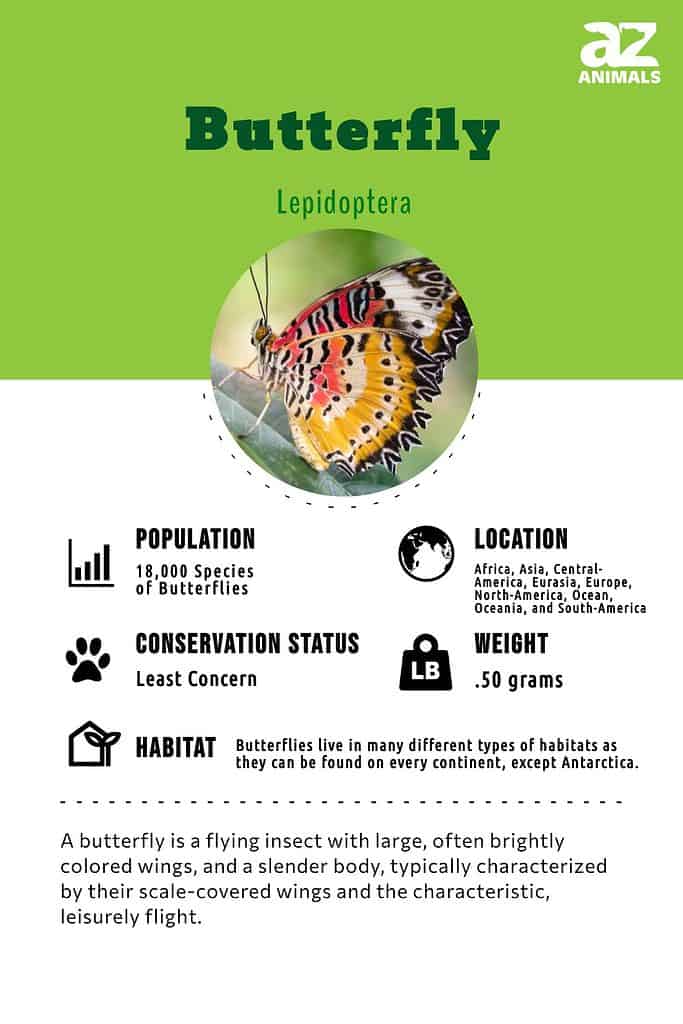
There are many different types of butterflies in the world, like swallowtails and monarchs.
They come in all different colors, including blue, white, pink, and brown. The life cycle of each butterfly starts out as a larva before it finally morphs into a beautiful butterfly. Butterflies are found on every continent, except Antarctica.
5 Incredible Butterfly Facts!
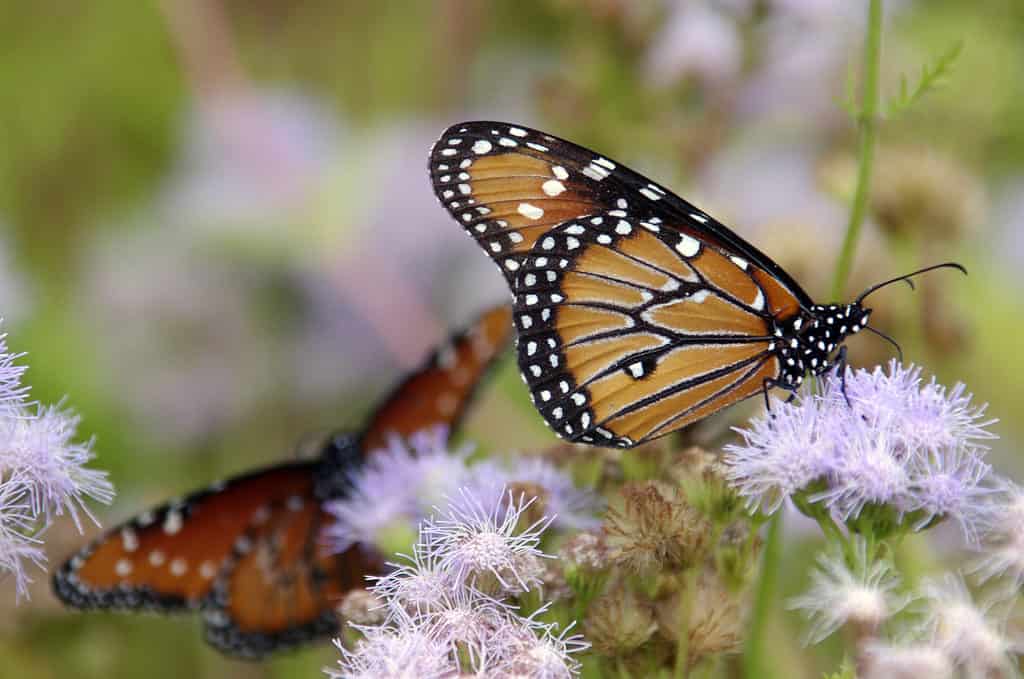
There are just under 18,000 species of butterflies in the world.
©iStock.com/MruthCotrofeld
- There are just under 18,000 species of butterflies in the world.
- Females of most species of butterflies are able to mate on the day of their emergence, but males have to wait several days.
- All adult butterflies live less than one year. Some species of butterflies can live up to 30 years before moving into the butterfly part of their life cycle, but the facts show that they may only live a day or two as an adult butterfly.
- Butterflies can fly up to 37 miles per hour.
- The facts show that the largest butterfly in the world is the Queen Alexandra’s birdwing. This butterflies wingspan can measure 10.7 inches.
Species, Types, and Scientific Names
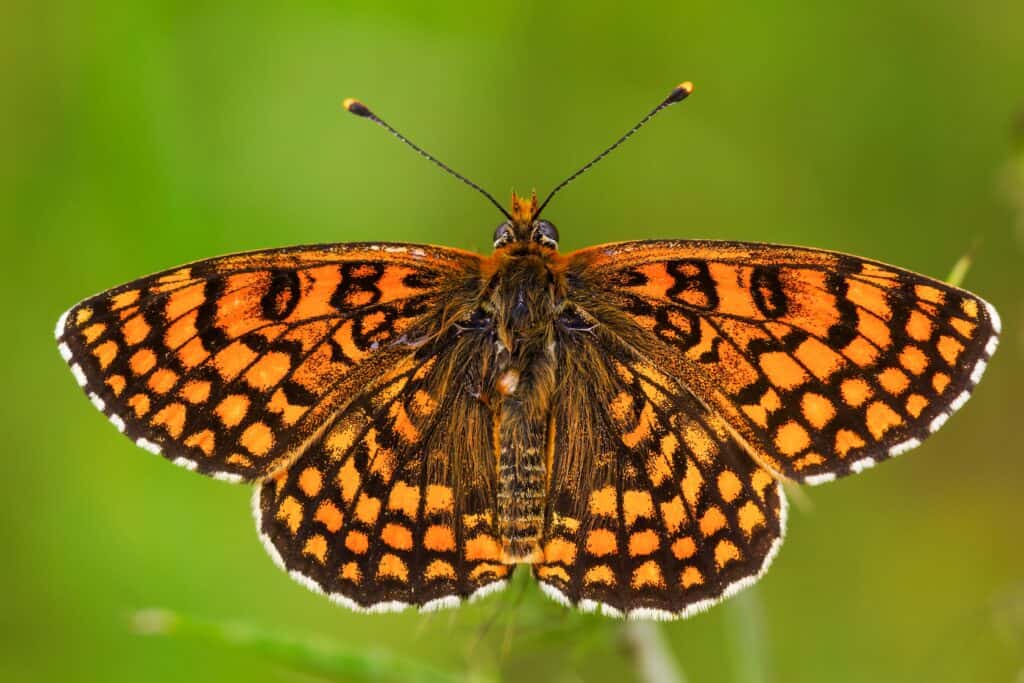
All butterflies and moths are members of the Lepidoptera order. In ancient Greek, the word “lepís “ means scale while the word “pterón” means wing.
©KRITPHOTO/Shutterstock.com
Butterflies are members of the Rhopalocera suborder. They are also members of the Arthropoda phylum and the Insecta class.
All butterflies and moths are members of the Lepidoptera order. In ancient Greek, the word “lepís “ means scale while the word “pterón” means wing, so the scientific name aptly fits these insects. Butterflies are divided into 46 superfamilies and 126 families, but each completes the same life cycle. About 10% of the known 180,000 species of butterflies and moths are alive today, with the greatest number of types found in Peru.
Butterflies are divided into six families. The Hesperiidae contains about 4,130 species, including:
- Pyrrhopyginae – These South American and Central American stout-bodied butterflies have about a 2-inch wingspan, and they live in forest canopies.
- Pyrginae – These temperate and tropical butterflies live near the ground, and they often rest with their wings held flat.
- Hesperiinae – These brown-and-orange butterflies that look kind of like a Monarch with about a 2-inch wingspan, similar to a swallowtail’s wings, live in temperate and tropical areas, including England.
- Coeliadinae – Often called policeman and awls, these butterflies live in Africa, Australia, and the Orient.
- Euschemoniinae -The only member of this subfamily is the Regent Skipper from Australia.
Another family of butterflies is the Papilionidae. These are often called swallowtails because there is often a small extension on their back wings. The caterpillars of these butterflies process an extra organ, called an osmaterium, that emits a foul smell as a defense mechanism. Members of this family that can be all different colors, including pink, include:
- Papilioninae – Many of these butterflies live in the Orient while others live in New Guinea, but they all flutter extremely quickly.
- Parnassiinae- These semi-transparent butterflies that can have a pink tint mostly live in Asia, but there are three species in North America and three in Europe. They are poisonous to all vertebrae.
- Baroniinae –Mexico’s orange-and-brown Baronia brevicornis which looks similar to a Monarch is the only member of this subfamily.
The next family is the Pieridae, and there are about 1,036 species in this family. These are found around the world, and most are brightly colored. They include the:
- Sulphurs, Yellows, Brimstones – Often called grass yellows and sulphurs, these butterflies migrate a long way, with most of them congregating in the Amazon region.
- Pierinae – These generalist butterflies that often have a white ground marked with black, orange, or yellow live all around the world from alpine meadows to tropical rainforests.
- Dismorphiinae – These tropical butterflies are sexually dimorphic and many are mimetic.
The next family is the Lycaenidae classification, and there are about 6,500 species in this subfamily. These small butterflies often have a metallic blue or coppery upper side, and they often live with ants who help to protect them and get a sugary substance needed to live from them. Members of this large subfamily include:
- Theclinae – These butterflies often live in the neotropics usually have white hairline streaks and usually have tails on their hindwings.
- Polyommatinae – The males of this subfamily generally have blue uppersides while females have orange ones, but they both have many dark spots on their undersides.
- Lycaeninae – Males of this subfamily that live in New Zealand and the Holarctic region set up territories where they defend against all insects.
- Poritiinae- These rainforest and cloud forest butterflies live in Asia, Malaysia, the Philippines, and Sulawesi, and they are some of the most iridescent butterflies in the world.
- Miletinae – These brown-and-white carnivorous butterflies live in Southeast Asia, Africa, and North America.
- Lipteninae – There are about 522 species of this butterfly that lives in Africa, where they normally live on or near fig trees.
- Liphyrinae – These African butterflies do not have a sucking instrument, called a proboscis, so they cannot eat.
Another family of butterflies is the Riodinidae classification, although some classification schemes list them as a subfamily of the Lycaenidae family. There are about 1,500 species of these butterflies. These butterflies are small, and they may have a metallic color. Subfamilies include:
- Riodinidae – These small butterflies from South and Central America often have bright metallic colors.
- Euselasiinae- There are at least 172 members of this subfamily that lives under leaves in the neotropical region.
Once considered families with their own scientific names, the Nymphalidae classification of butterflies all have very small forelegs that are useless for walking. There are about 6,000 different species that scientists usually divide into 22 subfamilies, including:
- Libytheinae- These butterflies that live in diverse locations globally have the ability to camouflage themselves so that they look like dead leaves.
- Nymphalinae – These are brush-footed butterflies that live around the globe.
- Heliconiinae – These small butterflies are often called passion-vine butterflies.
- Acraeinae – These butterflies are often orange and black live in Africa, Brazil, and Venezuela.
- Danainae – The larvae of the butterflies get toxins from their food and pass it on to the adult butterfly so that birds do not like their taste.
- Morphinae – Some of the biggest butterflies in the world, they usually have eyespots on their wings, which they can use as decoys to get away from their enemies.
Evolution and Origins
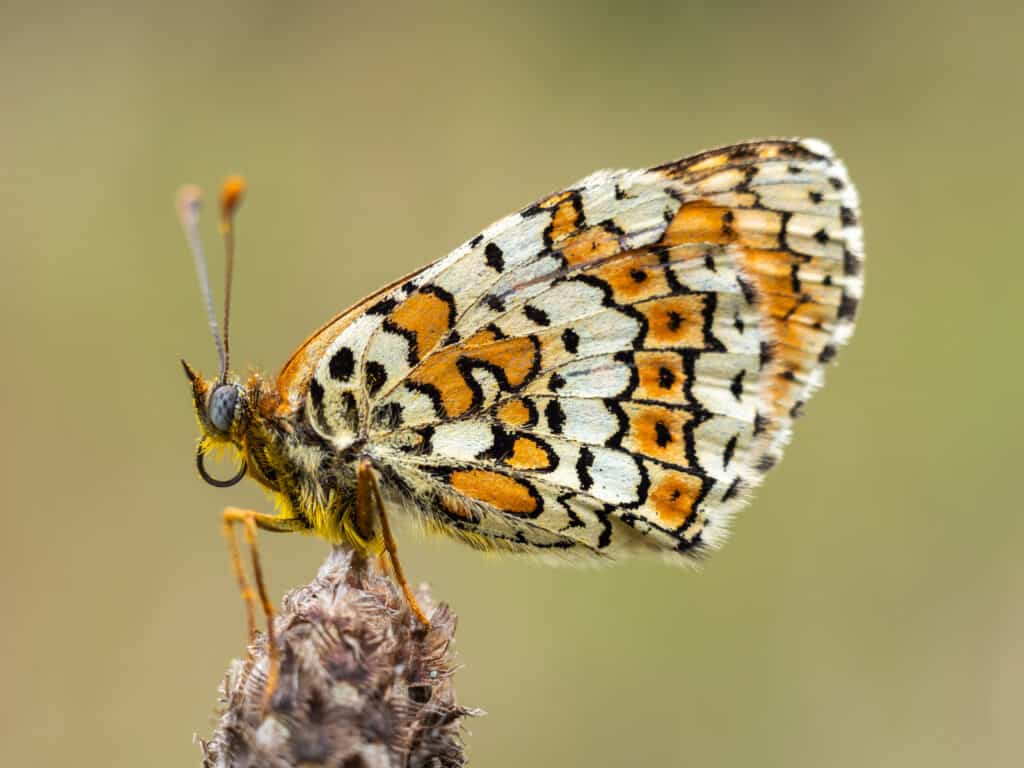
Butterflies are insects and are believed to have evolved from moths.
©Stefan Morris/Shutterstock.com
Butterflies are insects and are believed to have evolved from moths, which are their close relatives. The earliest known butterfly fossils date back to the mid-Eocene period, around 40 million years ago. During the early stages of their evolution, butterflies were likely small and dull-colored, similar to many moths today.
Over time, they evolved to become larger and more brightly colored as a result of adaptation to different environments and to better attract mates. The evolution of butterflies is also thought to have been influenced by the development of plants, as many butterflies have evolved to be able to feed on specific types of plants, and plants have also evolved to defend themselves from butterfly predation.
Appearance

©Joolyann/Shutterstock.com
Butterflies are very diverse insects. They have a three-part body consisting of the head, thorax, and chest. They also have six legs and two antennae. Most have scales on their wings and hair on their legs. They have compound eyes that they can use to see very well.
The biggest butterfly is Queen Alexandra’s birdwing, which is cared for by the staff at the Natural Museum of History in London. Its wingspan is about 10.7 inches. The smallest butterfly is the Western pygmy blue butterfly, which lives in California, Mexico, and Central America. Its wingspan measures about 0.5 inches across.
Habitat
Butterflies live in many different types of habitats as they can be found on every continent, except Antarctica. You can find some butterflies in deserts while others live in rainforests. Some live where it is very hot while others live in more moderate climates.
The highest number of different species of butterflies in the world is found in Peru. Many of them live in the Manu National Park, where over 1,300 species of butterflies have been recorded. Other countries with diverse butterfly populations, include Brazil, Colombia, and Ecuador.
Diet
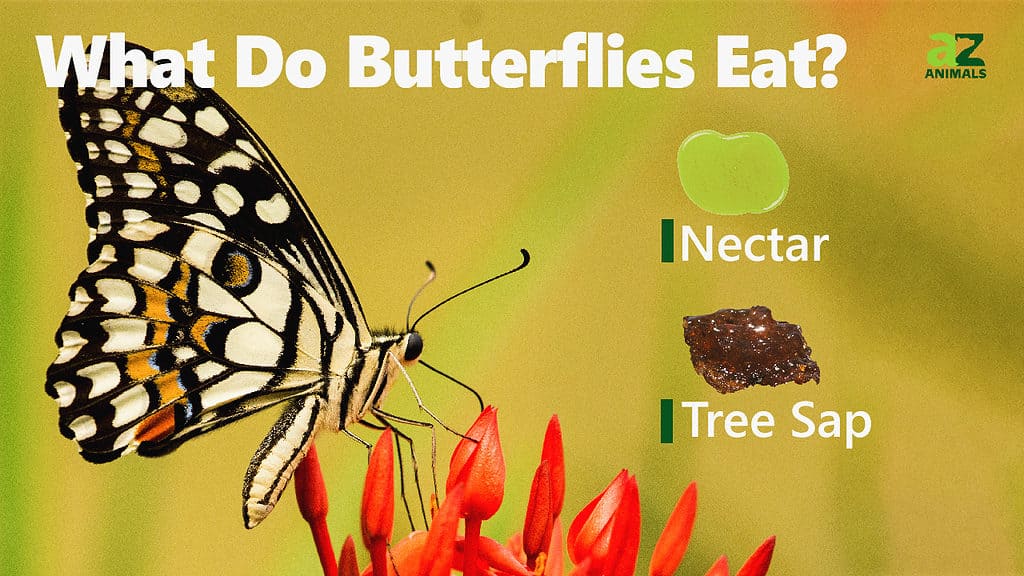
Most butterflies have one or two host plants that they prefer to dine on. While most prefer to suck the nectar out of plants as adults, some are carnivorous. For example, North America’s harvester butterfly eats only living wooly aphids.
Other species get nutrients from decaying plants. You can often find these species in areas where there are monsoons. The butterflies, like the Gluphisia crenata, drink up the water. Then, they release the fluids through their anal glands. This allows them to get salts and amino acids that their bodies need to thrive.
Even More Exciting Information
If you would like to learn even more intriguing facts about butterflies, including how many legs they possess, how to preserve them, which butterflies are poisonous, and which flowers attract them most, check out the articles below!
- Top 10 Smallest Butterflies in the World
- How Long Do Butterflies Live?
- 8 Most Unique Butterflies in the World
- How Many Legs Does a Butterfly Have?
- How to Preserve a Butterfly (in 6 Easy Steps)
- Where Do Butterflies Live?
- Fear of Butterflies: What’s It Called and Why Are Some People Scared of Butterflies?
- 10 Poisonous Butterflies
- Do Butterflies Bite?
- How Many Eyes Do Butterflies Have?
- What’s a Group of Butterflies Called?
- What Flowers Attract Butterflies?
- 10 Rarest Butterflies in the World
- Do Butterflies Lay Eggs?
- How Do Butterflies Eat?
- How Do Butterflies Reproduce?
- Raising Butterflies: How To Get Started Today
Butterfly FAQs (Frequently Asked Questions)
Are Butterflies herbivores, carnivores, or omnivores?
Butterflies are Herbivores, meaning they eat plants.
What Kingdom do Butterflies belong to?
Butterflies belong to the Kingdom Animalia.
What phylum do Butterflies belong to?
Butterflies belong to the phylum Arthropoda.
What class do Butterflies belong to?
Butterflies belong to the class Insecta.
Where do Butterflies live?
Butterflies are found worldwide.
In what type of habitat do Butterflies live?
Butterflies live in quiet forests and pastures.
What do Butterflies eat?
Butterflies eat nectar, pollen, and honey.
What are some predators of butterflies?
Predators of butterflies include bats, frogs, small mammals, and reptiles.
How many babies do Butterflies have?
The average number of babies a Butterfly has is 100.
What is an interesting fact about Butterflies?
There are thought to be up 20,000 species of Butterfly!
How many species of Butterfly are there?
There are 12,000 species of Butterfly.
What Do Butterflies Symbolize?
Butterflies have different meanings depending on the culture. For many Christians, they symbolize new birth. In Ancient Greece, butterflies were seen as a symbol of purity and immortality. Some see butterflies as a symbol that they need to relax and get rid of heavy thoughts. Others see them as a sign that a loved one has come to lend a helping hand when a person is going through a tough time.
What Are Three Interesting Facts About Butterflies?
- Butterflies live on every continent, except Antartica.
- Some adult butterflies lack the body parts necessary to feed as adults. Their diet of can be very varied, depending on the species from other insects, rotting plants and dirt, but most of them feed on nectar.
- They live in a variety of ecosystems from rainforests to desserts.
What Is Special About Butterflies?
Butterflies are among the world’s most colorful creations. Their wings are covered in tiny light-reflecting scales. When these scales fall off, then they often have areas on their bodies that look transparent.
Do Butterflies Fart?
Some butterflies use a process similar to farting to rid their bodies of excess water, through a process called mud puddling. This is especially common in species living where monsoons fall, and it is more common in males than in females. The butterfly takes in the moisture, which can be urine from other animals or water from decaying plants. Then, its body uses the nutrients from the water. The moisture that is not needed is forcibly expelled from the other end. Many species, such as the Gluphisia septentrionis, even fart at regular 3 second intervals.
What Happens if You Eat a Butterfly?
Eating one butterfly may give you an upset stomach, but it is not going to hurt you in most cases. Alternatively, eating a whole meal of nothing but these insects can make you very sick.
What's the difference between butterflies and dragonflies?
Dragonflies belong to a different order compared to butterflies, and most butterflies prefer to eat nectar. Dragonflies eat other insects.
How to say Butterfly in ...
Thank you for reading! Have some feedback for us? Contact the AZ Animals editorial team.
Sources
- Smithsonian, Available here: https://www.si.edu/spotlight/buginfo/butterfly
- The Children's Butterfly Site, Available here: https://www.kidsbutterfly.org/faq/general/12
- Wikipedia, Available here: https://en.wikipedia.org/wiki/Lepidoptera
- Learn About Butterflies, Available here: https://www.learnaboutbutterflies.com/Taxonomy%202.htm
- Enchanted Learning, Available here: https://www.enchantedlearning.com/subjects/butterfly/allabout/
- Research in Estonia, Available here: https://researchinestonia.eu/2018/10/03/butterflies-that-eat-ants/
- Lepscience, Available here: https://lepscience.com/2013/10/31/the-harvester-north-americas-only-carnivorous-butterfly/comment-page-1/
- Pets On Mom, Available here: https://animals.mom.com/types-butterflies-habitats-6729.html
- Sky Vine Butterflies, Available here: https://www.truebutterflies.com/blog/which-country-has-most-butterfly-species

















